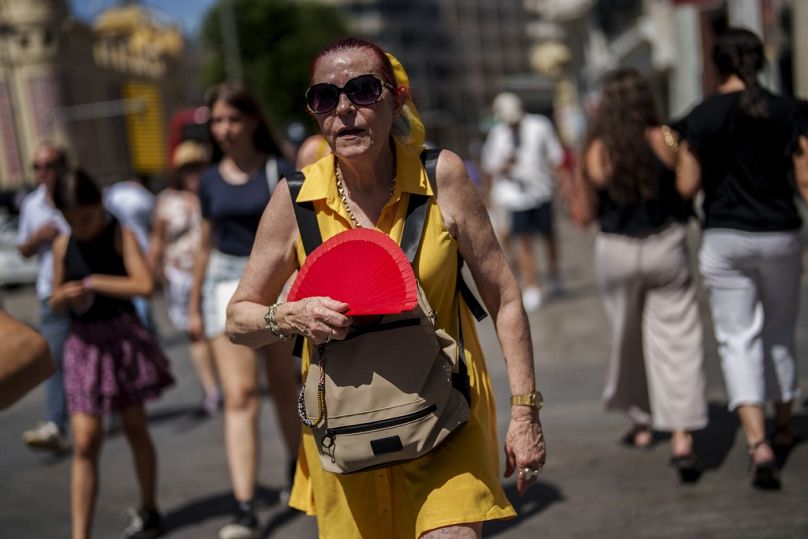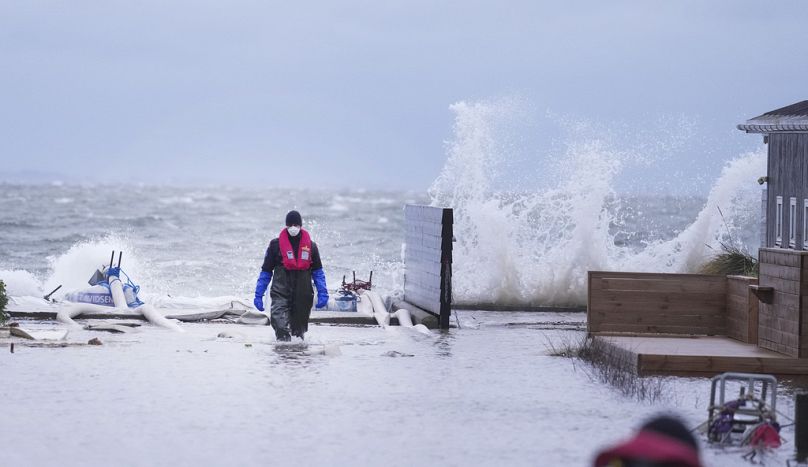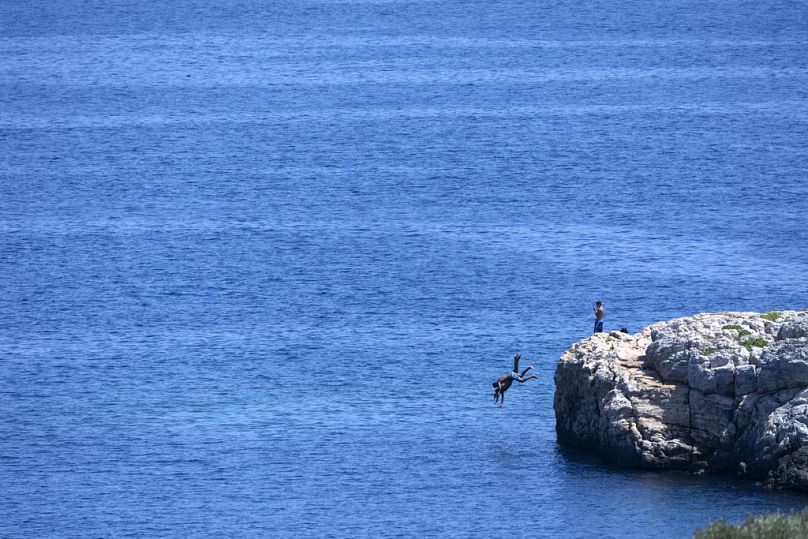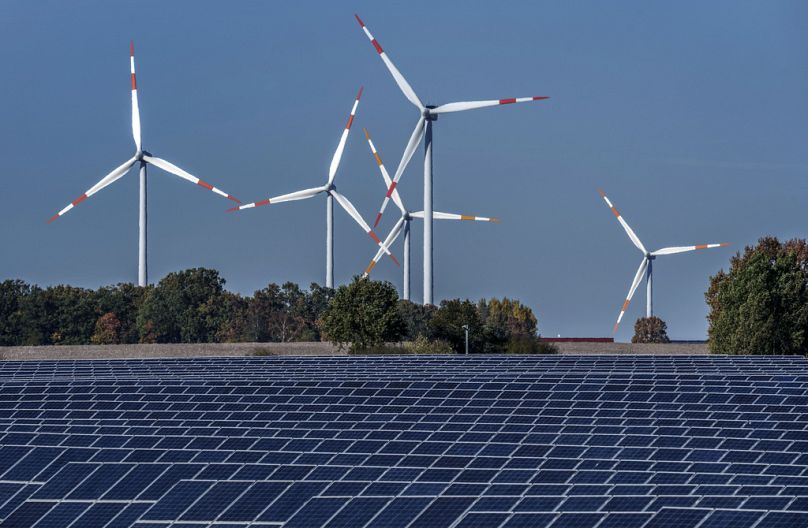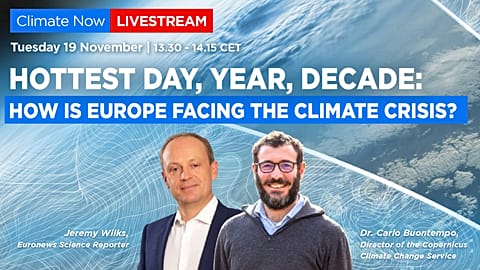More devastating wildfires and scorching temperatures, but also more rain and flooding. We asked experts to weigh in on the state of Europe's climate today, and how we can adapt to rapid changes.
With record-breaking temperatures and extreme weather events, Europe’s climate in 2023 was defined by contrasts, according to the EU’s Copernicus Climate Change Service (C3S) annual European State of the Climate report.
The world’s fastest-warming continent, Europe faced extreme heatwaves and large wildfires, but also more rain than average and more widespread flooding.
The EU’s largest wildfire was recorded in Greece in July, December had the highest winter flows on record and the northeast Atlantic Ocean saw its warmest marine heatwave on record in August.
In a live panel discussion, we were joined by experts to break down the key messages in the C3S report and try to answer the question: What really is the state of Europe’s climate today?
You can watch highlights from the Climate Now Live debate at the top of this article and a live replay of the full debate here:
For Diana Ürge-Vorsatz, Professor at the Central European University and Vice Chair of the Intergovernmental Panel on Climate Change (IPCC), the most striking moment of 2023 was seeing the record-breaking temperatures in September.
“We were quite shocked by how much warmer the summer was than anything before, and I thought, you know, that was the worst that we can see,” Ürge-Vorsatz said at the Euronews Climate Now live debate. “And then September came around and it exceeded any previous record.”
“Even my climate scientist colleagues, who work with such data every day, referred to this as ‘gobsmacking,’” she said.
Meet our panellists:
Samantha Burgess, Deputy Director, Copernicus Climate Change Service
Francesca Racioppi, Head of the World Health Organization European Centre for Environment and Health
Diana Ürge-Vorsatz, Professor at the Central European University and Vice Chair of the Intergovernmental Panel on Climate Change (IPCC)
Helen Findlay, Biological Oceanographer, Plymouth Marine Laboratory
Moderator, Jeremy Wilks, Euronews Science Correspondent
Can we handle the heat?
As humans, our health is intricately linked to our environment. When that environment shifts, it can have a lasting impact on our bodies. Hotter weather has been linked to cardiovascular issues and can even affect how our immune systems function.
In recent years, the climbing temperatures have led to multiplying incidents of “heat stress”, a condition where the human body can’t get rid of excess heat. In response, the body’s core temperature rises and heart rate goes up – and in extreme cases, it can even lead to death.
Across Europe, the number of days during which heat stress is experienced is climbing, according to the State of the Climate report. In 2023, there were a record number of days with "extreme heat stress", which is equivalent to a "feels like" temperature of more than 46°C.
Because of the prolonged heatwave in July, the World Health Organization (WHO) declared a public health emergency – the first time the UN agency ever designated heat as such.
“That was done because, for the first time, we really felt that we needed to really ring the highest possible alarm,” said Francesca Racioppi, the Head of the WHO’s European Centre for Environment and Health.
“To give you an idea, we were treating this along the lines of an emergency like COVID or the ongoing wars. So it was an unprecedented, terrible moment.”
Practically, the public health emergency designation activates a widespread public awareness campaign and gives the WHO the scope to work with governments to develop heat health action plans.
“What is important is to know what to do and to be able to do it, and to have the infrastructure needed to do it,” Racioppi said.
“These heat health action plans only work if they are connecting meteorological services with emergency services and with health services and social services,” she continued. “Because let’s not forget that many of those who are dying belong not only to vulnerable age groups but also vulnerable social groups.”
As many as 62,000 heat-related deaths were recorded in 2022 in just 35 countries, Racioppi said. Developing action plans is crucial to preventing more people from dying in the future.
There are a number of ways to mitigate heat stress, and some European countries have been testing them – like adjusting working hours during heatwaves to prevent exposure during peak temperatures or providing air-conditioned break rooms for outdoor workers or the elderly.
Wet, hot European summer
During 2023, Europe as a whole was around 7% wetter than average, the State of the Climate report found.
“Depending on the dataset used, it was the wettest year since 1981, so the wettest year for about 40 years,” said C3S Deputy Director Samantha Burgess.
But more than how much it rained, it’s important to look at how and when it rained, Burgess said.
“Because we have a warmer atmosphere with climate change, the atmosphere can hold more moisture,” she explained. “This means when we have rainfall events or storm events, they drop more rain more intensely than they have done historically in the past.”
The shifting climate is at the root of the shifting timing of European floods, as well as the increasing spatial scale of floods, Burgess said: “Local floods located on one river basin are becoming less common, and flooding across multiple river basins in multiple countries is becoming more common.”
Flooding was also responsible for 80% of the financial damages incurred by climate-related events in 2023, according to Burgess.
An ocean of trouble
The ocean absorbs carbon dioxide and excess heat from the atmosphere, which helps regulate temperatures around the world.
“The ocean has absorbed about 90% of excess heat that has been created from global warming, from human emissions of carbon dioxide and greenhouse gases,” said biological oceanographer Helen Findlay of Plymouth Marine Laboratory.
“So it is doing us a favour. The temperature in Europe would probably be quite significantly warmer if we didn’t have the ocean taking up that heat.”
But the scale and speed at which the oceans have been warming in recent years has alarmed scientists. For 2023, the average sea surface for the European ocean, which comprises Europe’s regional seas and oceanic areas, was the warmest on record, at 0.55°C above average.
In June, the northeast Atlantic off the coasts of the UK and Ireland experienced a major marine heatwave classified as “extreme”. Findlay described the conditions that led to this marine heatwave as a “perfect storm”.
“Obviously, you’ve got the year-on-year warming trends that we’ve seen,” she said. “But also there’s a pressure system that normally sits off the Azores called the Azores High Pressure (...) that was the weakest it was ever recorded in June. That has consequences on driving wind, so we actually saw a 20-30% reduction in wind at that time. And if you have less wind, then you actually have less circulation of the oceans, which prevents mixing with cold waters.”
Studies have found that the total number of days with marine heatwaves - averaged across the globe - has increased by 50% over the past century. In the future, marine heatwaves are expected to become even more frequent and intense and last longer due to climate change.
Marine heatwaves have wide-reaching consequences on wildlife, biodiversity and ocean currents. Scientists are also concerned about the effects they could have on ocean currents, which have a significant impact on the climate in general.
Adapting to a new reality
The European Union has for years been investing in strategies to adapt to the unavoidable consequences of climate change while trying to limit the damage through preventative measures.
According to the State of the Climate report, the EU is on the right track – in 2023, a record proportion of actual electricity generation in Europe was from renewable sources, at 43%, compared to 36% in 2022.
Adapting to a hotter planet also means rethinking cities – where 70% of Europe’s population lives – and building differently to reduce emissions and also reduce the need for energy, according to Ǔrge-Vorsatz.
“It’s much easier to supply all of our energy demand with clean forms of energy if we have lower levels of demand,” Ürge-Vorsatz said. “We have to work on how to provide the same or even better thermal comfort at lower levels of energy, by building good buildings so houses don’t get overheated, or more green and blue infrastructure, meaning more trees and ponds in cities, less concrete. That way we can better use the amount of available energy.”
Overall, all the panellists stressed that it was important to remain optimistic about Europe’s climate future.
“Hopefully the financial calculations and the scientific evidence are overwhelming to transition to that ambitious, rapid change that we so desperately need to get to net zero as quickly as possible and to adapt our cities to the current climate that we’re facing now,” Burgess said.
Investment in renewable energies is also a major priority for governments across the continent. Transitioning to clean energy sources like solar and wind will be key if the EU wants to hit its goal of reducing greenhouse gas emissions by 55% by 2030 and becoming climate neutral by 2050.
















